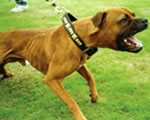 Go to main content
Go to main content
Archive Website of the UK government
Please note that this website has a UK government accesskeys system.
Main menu
Page menu
Home and community

Controlling your dog in public

It's your responsibility to make sure your dog behaves in public and is not out of control. Find out what ‘out of control’ means and what happens to dogs that are a danger to people or other animals. Also, learn how Dog Control Orders are made and enforced.
Out of control dogs
Report a dangerous dog to your council's dog warden service
It is an offence to allow a dog of any type or breed to be dangerously out of control:
- in a public place - like a street, park, bus shelter or the common parts of a block of flats (like the entrance or stairs)
- in a private place where the dog isn't allowed to be
Public areas also include fields, footpaths and beaches.
What is 'out of control'?
Your dog is dangerously out of control if it:
- injures a person, or
- behaves in a way that makes a person worried it might injure them - even if it's the dog owner's own home or garden
If you use your dog to injure someone you could be charged with 'malicious wounding'. The maximum penalty for this is five years in prison.
Other people's animals
A court could judge that your dog is dangerously out of control if:
- it injures another person's animal
- the owner of the animal thinks they could be injured if they tried to stop your dog attacking their animal
Penalties for out-of-control dogs
Anyone can report a dog and their owner to the police.
If you're found guilty of having a dog that's out of control you can be sent to prison for up to 6 months and/or fined. You may also not be allowed to own a dog in the future.
If you allow your dog to injure someone, you can be sent to prison for up to 2 years and/or fined.
The law about out of control dogs is covered in section three of the Dangerous Dogs Act 1991.
Barking dogs
For information on barking dogs, see ‘Owning and caring for a dog’.
Dog Control Orders
Local authorities in England and Wales have the power to issue Dog Control Orders. You should make yourself aware of any in your area. This might be different depending on which local authority looks after the area where you live.
Dog Control Orders mean that, in certain public areas, one or more of the rules below could apply:
- keeping your dog on a lead
- putting your dog on a lead when told to by the police, a police community support officer or someone authorised by the council
- not letting your dog go onto land that they should not - like farmland or specific areas of a park
- limiting the number of dogs you have with you at one time - 'professional' dog walkers are included
- clearing up after your dog
You can find advice on training your dog in ‘Owning and caring for a dog’.
Private land
Dog Control Orders don’t apply to private land if you have permission from the owner of the land or the person who controls the land.
Fixed penalty notices and fines
An authorised officer or a police officer can issue a £50 on-the-spot fine ('fixed penalty notice'). If you go to court and are found guilty, you can be fined up to £1000.
Registered blind dog owners are exempt from penalties.
Finding out about Dog Control orders
Councils must let the public know which areas are affected by Dog Control Orders. If they plan to put an order in place locally, they must first publish a 'notice' - normally in a local newspaper and the council's website. The order must include:
- details of the area the order applies to
- where you can see a map, if a map is referred to
- an address or email you can contact to have your say - you should be given at least 28 days from the date of the notice
After the 28-day period, your local authority will decide whether or not to go ahead with the order or amend it. If there are a lot of changes to the original order, the process to publish the notice starts again with the same timescales.
Knowing what land an order applies to
Your council should put up signs letting you know about planned orders. For example, if an order is made excluding dogs from a park. This should happen when the order is first made, after which permanent signs should be put up saying that dogs aren't allowed in the park.
Countryside Code
You should never let your dog walk in the same field as farm animals like sheep or cows. A farmer is allowed to kill your dog if it is worrying their livestock.
For more details about your responsibilities in the countryside, see ‘The Countryside Code’.
 Facebook
Facebook Twitter
Twitter StumbleUpon
StumbleUpon Delicious
Delicious Reddit
Reddit